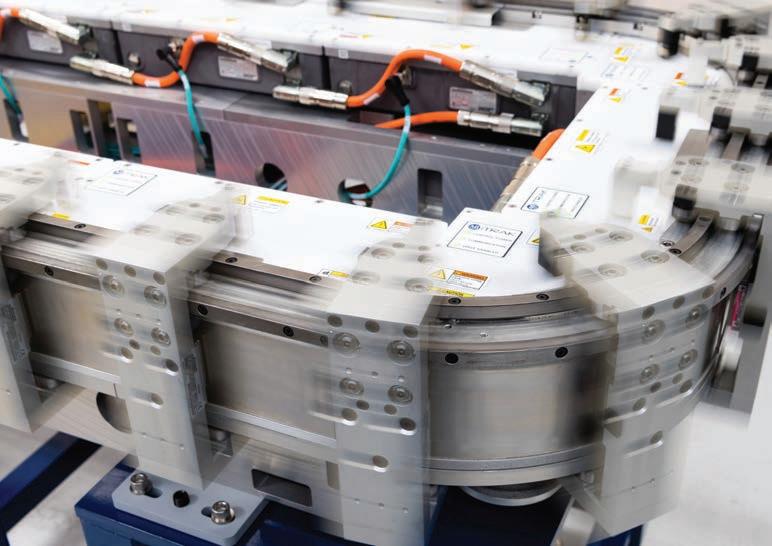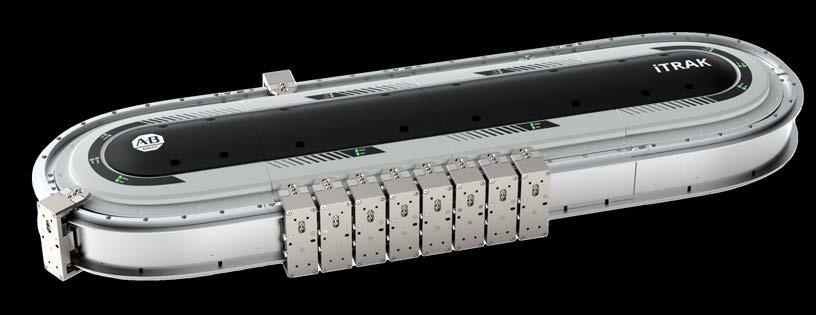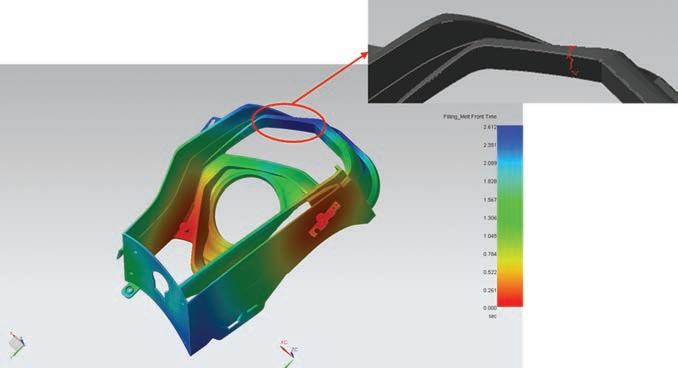
6 minute read
Smart Motion
Rockwell Automation’s iTRAK smart conveyor systems help facilities increase production rates, reduce changeover time and shrink machine footprint.
How intelligent conveyor systems help manufacturers overcome production challenges.
BY MICHAELA KAUFMANN
The global pandemic created a myriad of challenges for the manufacturing industry. E-commerce traffic has skyrocketed since 2020, with US sales projected to cross $1 trillion in 2022—a threshold previously forecasted to be met in 2024.
This dramatic increase pressures manufacturers to produce at higher, more flexible and more rapid levels than ever before.
Increased consumer demands, paired with labor shortages, have left many production facilities scrambling to meet market needs. Fortunately, smart motion solutions that simplify changeovers and offer advanced control of product transporting and positioning are helping manufacturers overcome these challenges with improved flexibility, faster cycle times and increased throughput.
One type of smart motion solution that is proving to be successful is intelligent track or conveyor systems that use independent cart technology (ICT). These systems independently control multiple carts on straight or curvilinear paths — or tracks — giving better control and flexibility of a line. The systems are software configured, can intelligently and efficiently manage the flow of a wide range of products and have fewer moving parts than conventional conveyance systems.
This flexible motion solution can help production facilities increase production rates, reduce downtime for changeovers, shrink machine footprint and help improve workforce productivity.
Optimizing Productivity
Flexibility is at the core of smart motion—and that flexibility lends itself to increased productivity. With the push of a button on a smart motion system with ICT, manufacturers can use software-configured profiles to perform toolless changeovers.
The system’s independent carts can also transport payloads of varying weights. And manufacturers can adjust and orient the system’s carts in a variety of ways to fit production needs. This allows the system to accommodate and efficiently produce a wide range of product types and sizes.
Smart motion systems with ICT can further boost uptime and productivity because they have fewer moving parts than conventional systems, creating fewer maintenance needs.
The systems also allow users to combine intermittent and continuous motion to help increase production rates. Full track and trace information from the system is also easily accessible to operators. This can help prevent product losses and reduce troubleshooting time when maintenance is needed.
Recovery time in the event of emergency shutdowns can also be greatly improved with smart motion systems. Exact cart position data allows users to restart the system immediately following a shutdown, unlike conventional mechanical systems that rely on motors to return instruments to a home position.
Improving Operations
Food and beverage, consumer packaged goods, household and personal care, automotive and material handling operations all stand to benefit from smart motion systems. But
CoroDrill® DS20

What innovation looks like
After years of R&D and customer testing, we are convinced – CoroDrill® DS20 is truly the best indexable short hole drill on the market. The concept consists of new designs for both drill body and inserts. It offers superior reliability and predictability with outstanding penetration rates for your 4–7×DC drilling operations. CoroDrill® DS20 is the first indexable drill to reach hole depths up to 7×DC – with no need for pilot drilling – reducing your cycle time and cost per hole.
We proudly welcome you to discover the new benchmark for indexable drilling – CoroDrill® DS20.
perhaps the most notable sector to gain from these systems is life sciences. Facilities producing pandemic necessities like masks and vaccines have needed technology with fast cycle times, easy serialization and flexibility to output materials to meet never-before-seen demands.
One example is the implementation of a smart motion system at a system integrator site where they make custom solutions for medical device manufacturing. The system is designed to move lighter loads quickly and efficiently using tracks that fit together in a variety of layouts for
fast changeovers.
In conjunction with these capabilities, the system integrator was able to simulate the motion system before it was onsite using a library of catalogue object-oriented programming code with drag-and-drop capabilities.
This way, the programming was completed upfront, and the entire machine line was able to be simulated as a digital twin, validating the design before the first prototype of the machine was built.
This saved tremendous amounts of time and execution. With traditional conveying, it would have taken about four weeks to connect and assemble all parts from a mechanical standpoint; however, because the system integrator simulated the system before installation, it took less than a week to start up and run without issue.
Outside of life sciences, other industries that have experienced high demand are also discovering how smart motion systems with ICT can help them keep pace with market needs.
Warehouse and logistics operations, for example, have needed to increase throughput to keep up with a boom in online sales. Smart motion systems have
helped operators more efficiently manage these complex operations. In some cases, facilities have boosted throughput in their package sorting operations by more than 15 percent.
Similarly, electric vehicle battery cell production, particularly in Asian-Pacific markets, can require large amounts of manual labor. ICT enables automated production with flexibility to build different battery levels on different lines.
Semiconductor producers are also seeing increased demands and need ways to make the production process more efficient. ICT solutions allow for better production with higher throughput and flexibility that fit into existing layouts. For example, the solution can leverage ceiling space to address space restraints and maximize facility usage.
Other Benefits of Smart Motion
Smart motion systems are playing a critical role in helping manufacturers address their top needs.
But the systems also have many other distinguishing characteristics that not only set them apart from traditional conveyor technologies but also address top needs.
For example, improving the ease and efficiency of jobs is crucial today given the skilled worker shortage. With fewer moving parts, easy-to-use controls and toolless changeovers, smart motion systems reduce operational complexity and demands on workers.
In addition, smart motion systems reduce energy usage. Each motor module isolates energy consumption on the track to only the engaged piece, leaving the remaining elements stalled. Energy is not consumed until the mover magnet is activated.
Smart motion technology also uses integrated safety rather than hardwired safety. This allows users to leverage functions like safe torque off with ease and confidence.
Given the above, these systems increase profitability. Shorter production runs and decreased maintenance needs paired with lowered energy usage can help manufacturers improve productivity, efficiency and in turn profitability.
In addition, manufacturers are increasingly interested in motion control systems that are self-aware and able to analyze data and can help optimize their own performance. Smart motion control systems can now provide this capability.
The system can be provided as a collection of devices that are aware of the larger system and adjust to its own feedback. By being self-aware, the system can monitor its own health and help users make decisions about performance using clear design data. Engineers can look at this design data to improve performance quickly and effectively.
The pandemic made it clear that manufacturers need greater flexibility, efficiency and ease-of-use than what can be provided by conventional conveyor and positioning systems. Smart motion technology is giving production facilities across sectors a more efficient, agile and intelligent approach to product flow to help them meet increased demands even with limited resources. |DE
rockwellautomation.com

Michaela Kaufmann is the Global Business Manager of Independent Cart Technology at Rockwell Automation.






